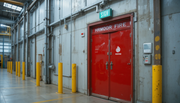Comprehensive Guide to Fire Door Maintenance: Ensuring Safety and Compliance
Fire doors are vital safety features designed to slow the spread of fire and smoke, safeguard escape routes, and protect lives. To maintain their effectiveness, regular inspections and prompt maintenance are essential. Failing to properly maintain fire doors can result in compromised fire resistance, legal penalties, and increased risk in the event of a fire.This guide outlines the key steps in fire door maintenance, what to inspect, how often to check components, and best practices for ensuring long-term functionality and compliance with UK fire safety regulations.
Fire Door Maintenance: How Often Should You Inspect?
Regular inspections are essential to keep fire doors in optimal condition. A minimum of biannual inspections (every six months) is recommended. However, high-traffic areas and doors located in critical safety routes should be checked more frequently—potentially on a quarterly basis—to account for increased wear and tear.
Key Factors Influencing Inspection Frequency:
- High-Traffic Areas: Doors used regularly by residents or staff experience more wear and require frequent checks.
- Weather Exposure: Exterior fire doors exposed to rain, humidity, or extreme temperatures may deteriorate faster.
- Critical Escape Routes: Fire doors on designated escape routes must always be in perfect working order.
Core Components to Inspect During Fire Door Maintenance
Proper fire door inspections should cover all essential components, ensuring each part functions as intended to resist fire and smoke. Below are the core areas to focus on during maintenance.
Visual Inspection: Identifying Surface Damage and Wear
- Door Leaf and Frame: Look for visible damage such as cracks, warping, dents, or delamination on the door leaf and frame. Even minor damage can impact the fire door’s integrity.
- Seals and Intumescent Strips: Examine seals around the door for cracks, missing sections, or wear. Intumescent strips—designed to expand under heat—should be intact and securely fitted.
- Smoke Seals: Check for any signs of deterioration, compression, or dislodgement that could hinder the door’s ability to block smoke.
- Surface Finish: Excessive wear like peeling paint, scratches, or swelling may indicate water damage or the need for refinishing.
- Fire Rating Label: Ensure the certification label remains legible, indicating the door’s fire rating (e.g., FD30) and manufacturer details.
Functionality Checks: Ensuring Smooth Operation and Security
- Door Closers: Test the door closer to ensure it operates smoothly, allowing the door to close fully and latch without slamming.
- Self-Closing Mechanism: The door must self-close from any angle without manual force. Malfunctioning closers should be repaired or replaced immediately.
- Door Swing and Alignment: Verify that the door swings freely without sticking, binding, or dragging on the floor.
- Latch and Lock Engagement: Confirm the latch fully engages with the strike plate, holding the door securely closed.
- Gaps Around the Frame: Check that gaps between the door and frame do not exceed recommended limits (usually 3-4mm). Excessive gaps can compromise fire resistance.
Seal and Intumescent Strip Inspection: Maintaining Fire and Smoke Resistance
- Seal Integrity: Look for cracks, peeling, or degradation in smoke seals and intumescent strips.
- Seal Fitment: Ensure seals make consistent contact with the door frame and are not loose or misaligned.
- Gaps or Missing Sections: Replace missing or damaged sections of intumescent strips immediately to maintain fire resistance.
Hinge and Hardware Checks: Stability and Security
- Hinge Condition: Inspect hinges for rust, wear, or loose screws. Each hinge should be securely fastened with all screws in place.
- Door Hardware: Check handles, locks, push plates, and panic bars to ensure they function correctly and are firmly attached.
- Fire-Resistant Hardware: Ensure all hardware is certified for use on fire doors and complies with relevant safety standards.
Areas Requiring Special Attention
Certain fire doors face additional challenges based on their location and usage. These areas require more frequent and detailed inspections.
- High-Traffic Doors: Fire doors in lobbies, hallways, or communal areas often suffer from accelerated wear due to constant use.
- Exterior Fire Doors: Regularly check for weather-related damage such as rust, corrosion, and water ingress that could compromise the door’s structural integrity.
- Fire Escape Routes: Fire doors on evacuation routes must always remain functional. Any issue impacting these doors should be addressed immediately to ensure safe egress during emergencies.
Maintenance Actions to Ensure Fire Door Longevity
Fire doors require more than inspections—they also need routine care to ensure continuous functionality. Incorporate these maintenance practices into your fire door management routine.
- Cleaning: Wipe down fire doors regularly using a damp cloth to remove dust, dirt, and grime that could affect hardware or seals.
- Lubrication: Apply lubricant to hinges, locks, and closers to ensure smooth operation and prevent squeaking or sticking.
- Tightening Hardware: Check screws, handles, and closers for looseness and tighten where necessary.
- Repairs and Replacements: Address damage or malfunctioning components promptly. Replace compromised seals, damaged intumescent strips, or faulty door closers as needed.
Compliance and Documentation: Staying Legally ProtectedRecord Keeping:
Maintain detailed records of all inspections, repairs, and maintenance activities. Your log should include:
- Inspection dates and times
- Findings and identified issues
- Actions taken, including repairs and replacements
- Names of individuals or contractors conducting inspections
These records are essential for demonstrating compliance during audits or fire safety inspections.
Professional Maintenance: While basic maintenance can be handled in-house, hiring qualified fire door specialists for annual inspections and complex repairs is highly recommended. Certified inspectors can identify issues that may go unnoticed during routine checks.
Adhering to Building Regulations: Ensure all fire door maintenance activities comply with local fire safety regulations, including the Regulatory Reform (Fire Safety) Order 2005 and British Standard BS 8214:2016. Non-compliance can result in fines, legal liability, and increased risk during fire emergencies.
Frequently Asked Questions (FAQs) About Fire Door Maintenance
Q: How often should fire doors be inspected?
A: Fire doors should be inspected at least every six months. High-traffic areas or critical escape routes may require more frequent checks—every three months or even monthly, depending on use.
Q: What is the acceptable gap around a fire door?
A: The recommended gap between the fire door and frame is typically between 3mm and 4mm. Gaps larger than this can compromise the door’s ability to prevent the spread of fire and smoke.
Q: Can I inspect fire doors myself, or do I need a professional?
A: Basic visual inspections can be done by trained staff, but annual inspections and complex assessments should be carried out by certified fire door inspectors to ensure compliance with UK regulations.
Q: What are intumescent strips, and why are they important?
A: Intumescent strips expand when exposed to heat, sealing gaps around the door to block fire and smoke. Damaged or missing strips reduce the door’s fire resistance and must be replaced.
Q: How do I know if my fire door is certified?
A: Check for a manufacturer’s label, typically found on the top or side of the door, indicating its fire resistance rating (e.g., FD30 or FD60) and compliance with British Standards.
Q: What are the most common fire door maintenance issues?
A: Common problems include damaged seals, faulty self-closing mechanisms, worn hinges, excessive gaps, and misaligned doors that fail to close properly.
Conclusion
Regular fire door maintenance is not only a legal requirement but also a crucial step in protecting lives and property. By following a structured inspection routine, addressing issues promptly, and ensuring compliance with fire safety standards, property owners and managers can significantly reduce fire risks.If you’re unsure about the condition of your fire doors or need expert guidance, consult a certified fire safety professional to carry out a thorough inspection and provide a clear maintenance plan. Proper fire door care could make all the difference in an emergency.



